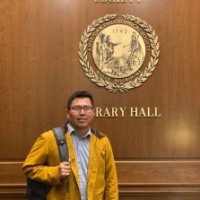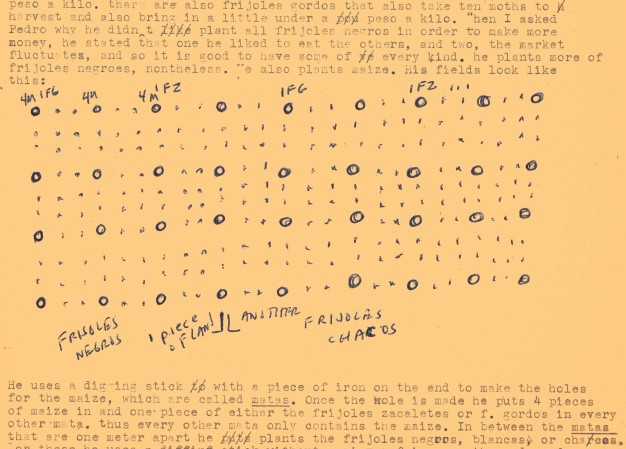Nahua Voices of the Huasteca Region at the American Philosophical Society
Header image: Sketch of Pedro Alatriste’s corn field in Zacapoaxtla, Puebla, showing how to sow beans and maize in the same field. Drawn by John Grady, 1965, Floyd G. Lounsbury Papers
In 2022, my wife Alberta Martínez, our two children Quetzaly and Mateo and I visited the American Philosophical Society (APS) in Philadelphia. I was the first recipient of the new Indigenous Community Research Fellowship to visit the APS's Library. In my short-term stay in the library, between May 16th and June 3rd, my goal was to listen, transcribe in Nahuatl, and to analyze Victoria Bricker’s materials collected in the spring of 1977, in the community named Huazalinguillo, Estado de Hidalgo, Mexico. I focused on four of Bricker's records narrated by the woman Antonia Osorio Naranjo. These narrations are:
All Saints (00:13:23 minutes)
Carnaval, a folk dance (00:30:19 minutes)
How to prepare tamales (00:23:28 minutes)
And the story of Xochitinih dancers (00:15:12 minutes)
I am very interested in these short narrations because I was born in Chicontepec, Mexico, very close to Huazalinguillo, and this language partakes of the same dialect of Nahuatl. I also spent time reading the Nahuatl papers collected by anthropologists like Franz Boas, and more language documentation made by linguists such as John Grady (1965), F. R. Higgins (1971), and Timothy Knab (1975), who conducted ethnographic fieldwork in Nahua communities, such as Zacapoaxtla and Huahuaxtla, Puebla, and in central Mexico.
My doctoral dissertation, “Motiochihuanih: Catechists and Prayer Specialists as Religious Leaders Brokering ‘el costumbre’ in Nahua Chicontepec, Veracruz,” (2022) examines religion as it is practiced in the township of Chicontepec, which is located in the Huasteca Veracruzana. Using oral histories that date to 1980 and qualitative ethnographic research in the present, my study focuses on four motiochihuanih. Motiochihuanih are religious leaders trained as catechists by the Catholic Church who later became prayer specialists (rezanderos). The narrations offered by Antonia Osorio Naranjo and Bricker’s two notebooks of fieldnotes provided me a good perspective of oral stories that depict “community memories” of Nahua inhabitants living in rural places in Mexico.
After my unforgettable time at the APS in Philadelphia, my family and I returned to Salt Lake City. It was a great pleasure to know to Brian Carpenter, Adrianna Link and Ruth Rouvier, who I received a lot of support and advice from. This academic year I continue teaching Nahuatl as a second language for students from the University of Utah, the Salt Lake Community College, and virtually for students from the UC Berkeley. At the same time, I continue developing my research on the Nahua Religious Traditions in the Department of Latin American Studies at the University of Utah.
Video caption: Nahuatlahtolli ipan Amoxcalli tlen Sociedad Filosófica Americana (Speech in Nahuatl at the American Philosophical Society Library)
Given my great experience as a fellow at the APS, I decided to make a video where I use my mother tongue inviting scholars or non-scholars to consult Nahuatl materials housed in several collections at the APS. Finally, I encourage to Indigenous people to apply to the several fellowships offered by the American Philosophical Society.


